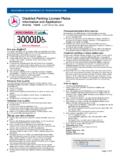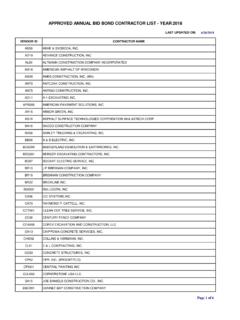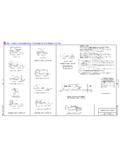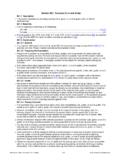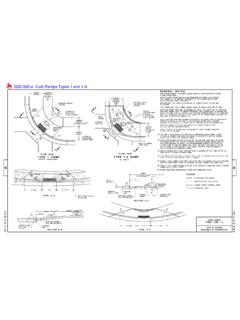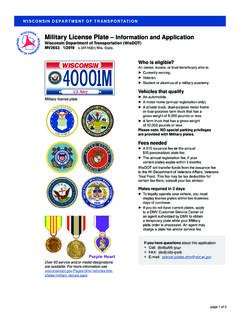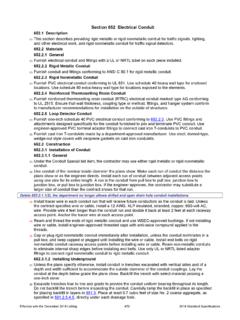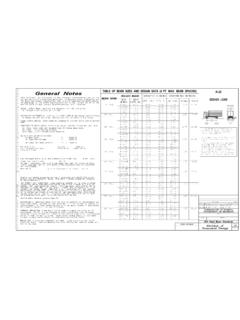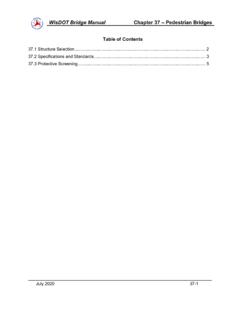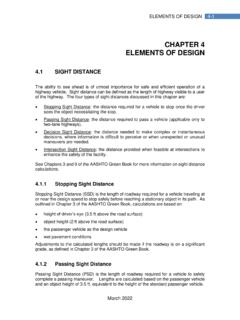Transcription of Facilities Development Manual Wisconsin Department of ...
1 Page 1 Facilities Development Manual Wisconsin Department of TransportationChapter 11 design Section 10 design Controls FDM 11-10-1 B asic Criteria May 15, 2019 design Year The design years for projects are normally 20 years from the date projects are proposed to be opened to traffic. Shorter design periods may be used when highways are to be constructed in stages or designed for shorter pavement improvement life-spans. Traffic Cooperate with the region's planning staff to develop design traffic data. Traffic data includes current and design year average daily traffic, design hourly volumes, directional distributions, and the percentages of heavy vehicles expected in the design year.
2 Normally trucks and buses are the heavy vehicles considered as influencing highway capacities. Also, consider heavy recreational vehicles on certain routes. Include bicycle and pedestrian counts when requesting intersection traffic counts. Highway Capacity Capacity is an important factor in highway design and operation. Through capacity analyses, proposed highways can be designed to operate at predicted traffic volumes without exceeding pre-selected levels of service. Early programming and scoping processes will be the first evaluations to determine if capacity issues will be addressed or not and to what levels of scope.
3 Generally, - Perpetuation projects will generally not explore capacity improvements,- Rehabilitation projects will explore limited capacity improvements in the form of incremental improvements or safety mitigation measures as defined in the projects purpose and need,- Reconstruction-Type Modernization projects will explore more project segments/locations for incremental improvements, as defined in the projects purpose and need, and- New Construction-Type Modernization projects will fully explore capacity expansion improvements as defined in the projects purpose and to FDM 11-5-3 for highway capacity procedures.
4 Functional Classification Functional classification is the process by which streets and highways are grouped into classes or systems according to the character of service they are intended to provide. The basic functional systems used in highway planning are arterials, collectors, and locals. Using national classification terminology, these systems are sub-classified based on the trips served, the areas served, and the operational characteristics of the streets or highways. These systems are detailed on Wisconsin 's current Functional Classification Systems Maps: design Speeds According to AASHTO1, design speed is a selected speed used to determine the various geometric design features of the roadway.
5 Selected design speeds should be logical ones with respect to the topography, anticipated operating speeds, the adjacent land uses, and the functional classifications of the highways. Selections of design speeds are very important because these choices set limits for curvatures, sight distances, clear zones, and other geometric and cross-sectional features. The types and functional classifications of highways, topographies, adjacent land uses, driver expectations, and economics are all factors influencing these selections. Speed measurements on highways of different design speeds and various traffic volumes typically show wide ranges of actual vehicle running speeds.
6 In order to satisfy the desired travel speeds of most drivers, consideration should be given to selecting design speeds that are high-percentile values in the speed distribution ranges. Average running speeds will then normally be lower than the design speeds, because of the 1 (1) A Policy on Geometric design of Highways and Streets 2004, 5th edition. aashto , 2004., FDM 11-10 design Controls Page 2 influences of traffic volumes, physical limitations of the highways, and speed limits. Speed measurements on rural arterial highways in Wisconsin show the average running speeds to be in excess of the posted speeds.
7 These studies support upper range design speeds for rural arterials on the state trunk highway system that are 5 mph greater than posted speeds. Table provides corresponding English and metric design speeds with typical posted speeds. Table design Speeds vs. Typical Posted Speeds Posted Speed (mph) design Speed (mph) 25 25-3030 30-3535 35-4040 40-4545 45-5050 50-5555 55-6060 60-6565 65-7070 70-75 Use of design Speeds equal to Posted Speeds are acceptable if the Safety Certification Document (SCD) (See FDM 11-38) or other safety analyses show acceptable safety performance on the existing roadways.
8 Existing two-lane roadways being expanded to four lanes are good candidates for these 70-75 MPH design speeds also where the following conditions exist: cross sections of the roadways will be divided, opposing traffic will be separated by medians or traffic planned highways meet the requirements for freeways or expressways as defined in Section (1) of the Wisconsin when checked with the regional traffic unit, it is confirmed that the highway segments are long enough to allow the practical use of the higher design are no signals or stop conditions on the highway median widths on expressways equal or exceed the clear zone widths required for 70 mph design speeds.
9 Note: It is generally not practical to use median barriers on non-access-controlled highways because the barriers can obstruct the vision of drivers at intersections and safety treating the ends of interrupted barriers can be difficult. However, the use of a median barriers would be appropriate for freeways with narrow 70 mph (110 km/h) design speed is also used under the following conditions: speeds of 70-75 mph exists on multilane divided highways where existing acceptable safety performance exists, which will be improved or that qualify for expansion projects (2-lanes to 4-lanes divided) and have crash rates that are less than 25 percent above the statewide average rates for similar types of highways, and have 85th percentile speeds of at least 70-75 design speeds may be considered on Special corridors that serve more of access, tourist or aesthetic related functions than mobility functions.
10 These Special corridors might be Rustic Roads, Scenic Byways, FDM 11-10 design Controls Page 3 sections of urban corridors with high pedestrian activity or in the vicinities of schools, or other roadways located in unique environmentally or socially sensitive areas. Using lower design speeds can help to provide additional flexibility in the design of horizontal, vertical and cross-sectional elements. Identify these lower design speed corridors in the Scoping Phase of the project Development process. Selections of design speeds need to be mutually agreed on between the planning, traffic and project Development sections.
